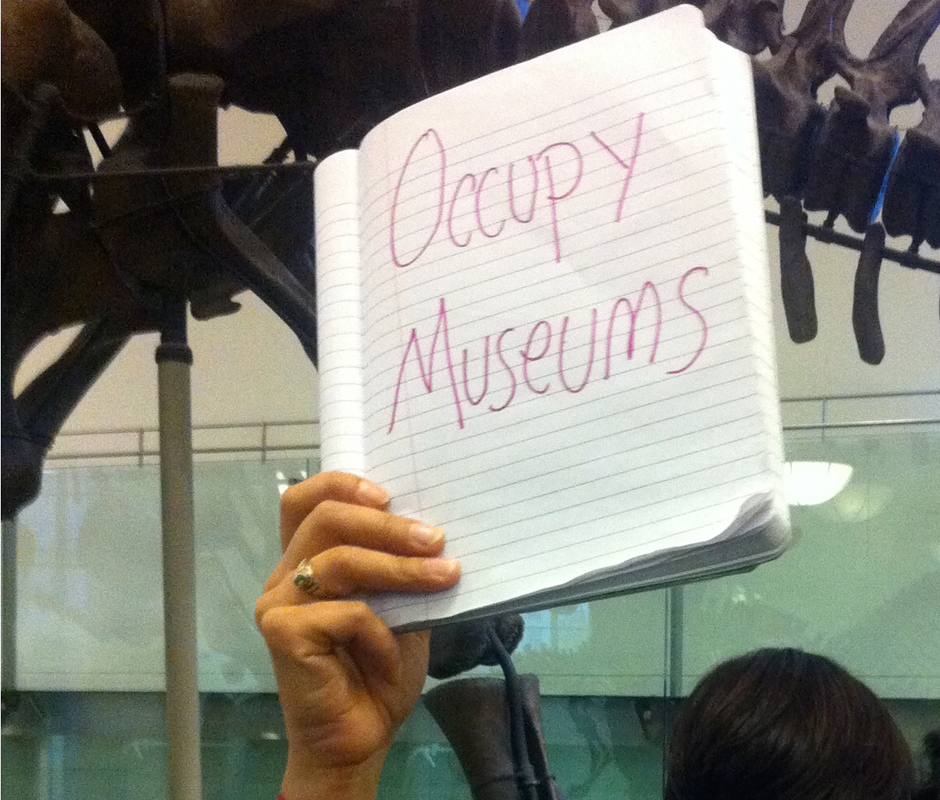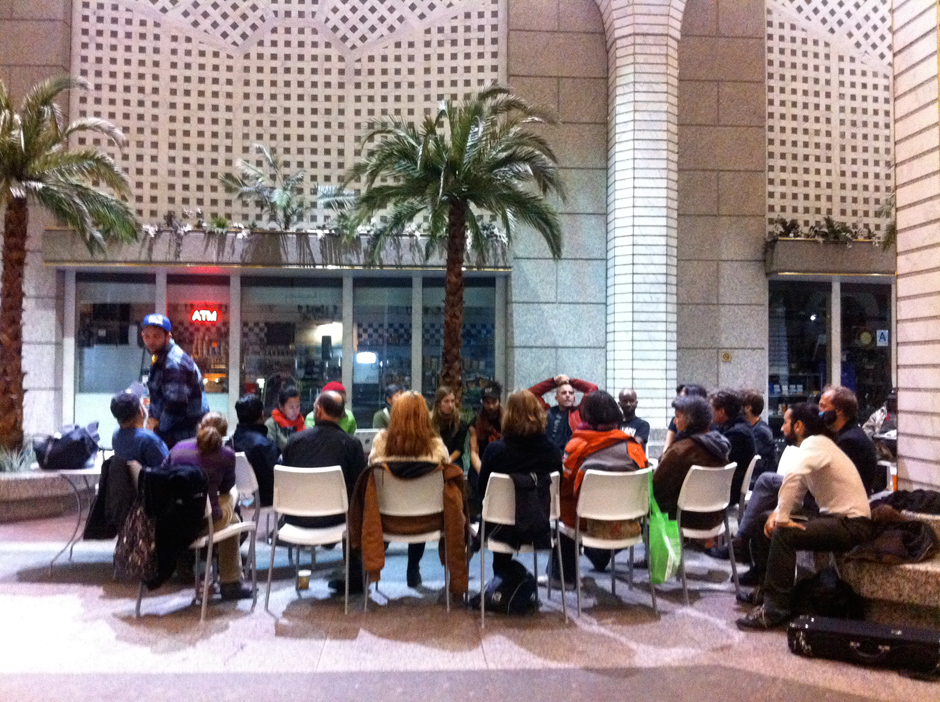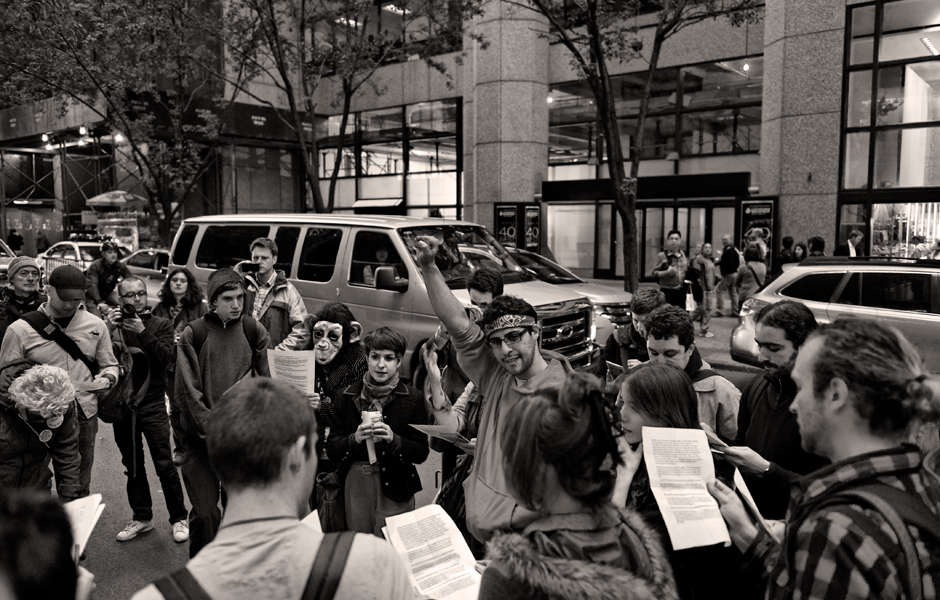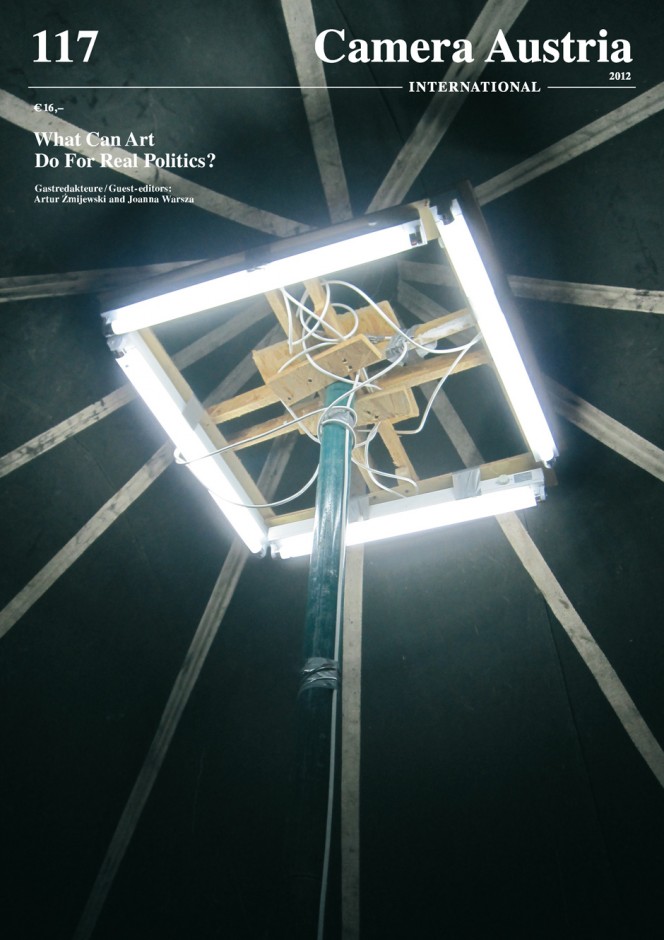Manifest of “Occupy Museums”
WE OCCUPY MUSEUMS TO RECLAIM SPACE FOR MEANINGFUL CULTURE BY AND FOR THE 99%. WE BELIEVE THAT ART AND CULTURE ARE THE SOUL OF THE COMMONS. ART IS NOT A LUXURY!More >

A video of an action of "Occupy Museums"

Noah Fischer, Photo: Joanna Warsza

Assembley in the National History Museum, Photo: Joanna Warsza

"Occupy Museums" at MoMA, Photo: Noah Fischer

Policeman in front of MoMA, Photo: Noah Fischer
Occupy a Museum Near You!
Noah Fischer in conversation with Joanna Warsza and Florian Malzacher
Joanna Warsza and Florian Malzacher: You are the initiator of the Occupy Museums group, associated with Occupy Wall Street. First you organised a protest march to MoMA, and later you occupied the New Museum and other art institutions run by the 1 %. You staged a general assembly in front of the museums, to read your manifesto where the injustices of the arts and culture system are listed. When the director of MoMA asked what it is that you wanted, you replied that you had no demands. “But,” you said, “we would continue to occupy the museum in order to open up a conversation about economic injustice and abuse of the public values for the gain of the 1 % in the art world.” Why shall we occupy museums?
Noah Fischer: Occupy Museums is a collective, which runs by consensus. I initiated the first Occupy Museums action in October 2011. Our group formed soon after that. Every action and official text we create is authored by all of us, and we don’t have a single leader. Functioning in solidarity is the spirit of the Occupy Wall Street movement. We are trying to forget about the drive toward individualism and hierarchy, which is so much a part of the capitalistic regime. We also believe in individual autonomy. First I want to make it clear that these are my own opinions; I can’t speak for the whole Occupy Museums group.
So, why do we Occupy Museums? Today museums are an important part of the neo-liberal system, which we are protesting on Wall Street. Museums are like temples of this system, actually; they reproduce the logic of the system, reify its symbols, and are financially dependent on it. Actions by Occupy Museums are about opening up a very large, honest, transformative conversation about the presence of money and power in the world of art and culture.
And why museums but not private galleries? Because museums hold cultural authority and carry out a supposedly purely public function that galleries and art fairs do not have. Currently, the main art-world paradigm in the US is a private market of artists that are represented by a hierarchy of galleries, and these galleries want to get their artists into the Whitney Biennial or the New Museum or, eventually, into the Museum of Modern Art. Therefore, an artist’s career and markets are built up through the cultural authority of the museums. Nothing else counts but your symbolic and financial position, and museums have the power to shape this. The problem is that, just like on Wall Street, the wealthiest 1 % control nearly everything. They engage in philanthropy, of course, and sit on museum boards, and these are often also the mega-collectors who influence the markets. Actually, the whole arts infrastructure has been organising around these few individuals in the last 30 years. They concentrate political power and social prestige in their hands, perhaps even more than money, if this is possible. But real, essential culture needs distance from this power and influence in order to grow and thrive, otherwise culture becomes a luxury commodity. What will hopefully come out of the Occupy Museums is a re-thinking about the current state of culture, which is very close to a luxury item for the wealthiest. How can we reconnect our work as artists to the experience of ordinary people—the 99 %? We have already found a way to connect as artists to the spirit of protest in the air. For the first stage we are publicly defining cultural injustices—inviting people to call them out in open assemblies at the museums. A lot of information about the corruption and conflicts of interest on museum boards arises from the participants in these assemblies. But maybe the most important thing Occupy Museums is doing is publically demonstrating, through solidarity, that we artists need not be silenced by these powerful institutions that wield so much cultural authority, just because the 1 % sits on their boards. We are learning not to fear, but to act.
The first museums you went to were MoMA and the National History Museum. Why these two?
MoMA is an iconic New York museum, because it is “the one and only” Museum of Modern Art. And New York is a city that is supposed to have made its name on the international stage through modern art. MoMA, therefore, is very much a temple, a holy space where the local gods such as Pollock and Newman dwell. It is also transparently financially corrupted. Two MoMA trustees, James Niven and Richard Oldenberg, also have connections to the board of Sotheby’s. These trustees help to inflate prices in the art auctions, and they presumably have some vote or influence about what is shown in the museum. This simultaneous conflict of interest should be unacceptable and considered as abuse, but in the US now, it’s become accepted—we also see it in the revolving door between the US government and the biggest corporations such as banks. But people would be surprised to find these problems associated with museums, even though the art market is extremely unregulated. And it is precisely because MoMA is iconic and also beloved and trusted by many that Occupy Museums decided to go after it and make it into an example. We are going straight to the top, “storming the temple”. In fact, we do not really occupy physical places—we rather occupy people’s consciousness, symbols.
But the Natural History museum is not specifically related to art.
Here we focused on the potential menace of philanthropy. We occupied the Dinosaur wing in the American Museum of Natural History, whose patron, David H. Koch, is the second richest person in New York and a major funder of the ultra right-wing in the US. For this action, we were talking to visitors at the Museum about the ideology associated with his “gifts”. David H. Koch has been the primary funder of the Tea Party, right-wing think tanks, and numerous initiatives which try to negate global warming. Often he has censored climate information in the exhibitions that he sponsors. His father, who built the family fortune, was also a right-wing ideologue in the McCarthy era who used the threat of communism to create a political platform full of racism and bigotry—this is actually the pre-history of the Tea Party. We also discussed how the funding of culture is often used to clean the image of those that make dirty money (Koch makes his money from the oil and energy business, and his companies are known for polluting). At the Museum of Natural History, we created a series of performances followed by a discussion of what alternative models of philanthropy might look like, such as more government support or support from many smaller contributions. Obviously, we are just beginning this discussion.
When the director of MoMA came to talk, you refused. Why? Aren’t you interested in a productive dialogue?
For the first action, we held a General Assembly meeting in front of MoMA and read a manifesto, and then the director and a couple other staff members came down to meet us. They were very nice and said that they support the movement to some extent and asked why we were there. I answered very much in line with the manifesto, that we believe that MoMA is the temple of the 1 %, and our aim is to challenge this concentration of power and wealth, which is crippling our culture and futures as artists. They were surprised and asked for our demands. I said we have no demands, but we are going to continue occupying their museum, which in this case means repeatedly coming back and enlarging the conversation until it is much more visible and spread out. Actually, for a long time, the press kept asking for demands of the Occupy Wall Street movement. So far it has been very helpful for the movement to not have demands. As soon as you have demands, you’re asking those with power to change something finite (a few things), when many feel that the problem is structural. Without demands, we focus more on developing our voice autonomously and building our movement’s solidarity, which is the base of our power. The problems of economic injustice are so big that starting out in a negotiation mode does not make sense.
Later on you also did an action at Lincoln Center in New York …
That was our most triumphant action! The Lincoln Center, supported by David H. Koch and New York’s mayor Michael Bloomberg, is a potent symbol of the privatisation of public space and an abuse of cultural authority. As we stated in the press release for the action, “it is no doubt a coincidence that Philip Glass’ opera ‘Satyagraha’, which depicts Gandhi’s early struggle against colonial oppression in India, was revived in the revolutionary 2011. We immediately saw a glaring contradiction in ‘Satyagraha’ being performed while in recent weeks protestors from Occupy Wall Street have been arrested. The juxtaposition was stark. While Bloomberg funds the representation of Gandhi’s pioneering tactics of nonviolent civil disobedience in the Metropolitan Opera House, he simultaneously orders a paramilitary-style raid on the peaceful public occupation of Liberty Park, where protestors are beaten, tear-gassed, and violently arrested.” So, one evening, hundreds of protesters assembled on the steps of Lincoln Center, blocked off from the plaza by police barricades. A few who dared to cross the line were arrested, provoking shouts of “shame, shame, shame!” We took off our shoes—a Gandhian symbol of dignity—and stood barefoot on the cold pavement, conducting our assembly. When the opera ended and the opera audience exited into the plaza, they came upon this strikingly theatrical scene—real, live, non-violent protest, barefoot on the grand steps! Some protesters were chanting “We are the 99 %”, which may have contributed to a sense of separation between these two parallel crowds. Our presence behind the police barricades somehow paralysed the opera audience, making them hesitant to flow toward us, even as we called them to join. Then all of a sudden Philip Glass popped up in the Occupy Wall Street crowd—he had come to read a statement using the “people’s microphone”. He called out the last lines of the opera, a passage from the “Bhagavad Gita”:
When righteousness withers away / And evil rules the land / We come into being / Age after age / And take visible shape / And move / A man among men / For the protection of good / Thrusting back evil / And setting virtue / On her seat again.
In that moment the opera audience had joined us. The buffer zone was gone. We were now one big crowd. Until late into the night we held our general assembly and many people spoke—opera singers who had been recently fired by Lincoln Center in its neo-liberal war against workers, and also Lou Reed was there to express his support.
Occupy Museums is very careful of not being co-opted by any institution. You refuse any collaboration, even if this is how you could reach out.
Since the beginning of Occupy Wall Street, co-option has been a major concern, because neo-liberal capitalism knows very well that the best way to kill protest movements is to absorb them into the existing market and to dissolve them or use them for advertising purposes. If we started to negotiate with MoMA, they might say, “You may use the first floor for a special General Assembly, we’ll put it on the website.” In this way, they might try to throw us a bone before they deal with critique we raise. And then while negotiating, we might have our ego pumped and feel special because these famous gatekeeping institutions have opened their gates for us just a little.
It is of course not so black and white because many people who are in the movement work for art institutions; some are even powerful curators, critics, and well-known artists. We of course also need to find allies to change structures of the institutions from the inside. The question is how to proceed in this while keeping our clarity of critique? Now we are reflecting deeply on how we may interact with institutions, which are just groups of people, to develop and apply our vision of economic justice, but being very mindful of how we proceed.
I feel that before we join the people who run the museums, we should join in solidarity with the wider communities of New York City—artists and art lovers who are not so privileged. New York City has the same wealth disparity as Honduras. It is one of the richest and the most class-divided cities in the world. It has not much of a middle class, but a lot of very wealthy and a lot of very poor people. It also has many extremely rich artists and a vast number of poor artists. Tourists visit the galleries in Chelsea and don’t understand that they are in one of the poorest cities in the US, with the poverty hidden in the outskirts. Those are the economic and racial barriers, which have been built up for generations, that we have to break. It’s the key part of the process for real change. We must bring together wider communities that usually do not hang out together in the art world, and change the class and race segregation that we see in culture, even if this takes lots of work and lots of time.
And why not reach out to the 1,000 people who are coming to the Natural History Museum every day anyway? Or the daily visitors of MoMA? Those are the ready-made audiences.
The museum-going audience is always invited to take part in our actions. As we saw at Lincoln Center, their decision as a group to join the protest gave our action much of its strength. So we are definitely outreaching and engaging with this existing art-audience, too. But we are careful to maintain our stance as activists. We can engage an audience, but we don’t force people—it has to be their choice. Look how people consume culture as a product. That’s this “consumerist subconscious” which homogenises and unites the whole reality under the logo of a consumable product. I think our job is to stay awake and critical, to keep the tension of the moment going, and people will join us.
If you were the director of MoMA, what would you do in these circumstances?
It would be cool for the MoMA director to join us in an open conversation with our group. Curators at MoMA are used to having their asses kissed by artists, but maybe they would be interested in a new dynamic where everyone is equal, where people are focused on justice and mass consciousness rather than just on individual competitive gain? They could join the discussion, because then we could find out—outside the power relations—what they think as individuals. Many people want to see big changes in our world—I’m sure some museum directors do, too. We all need to get started, so they could begin by meeting us if they want. There is nothing stopping them—our group is open.
So what must institutions that would like to join be prepared to face?
They’d have to be ready to step into the mud. They’d have to be ready for a long, uncomfortable conversation. Our movement calls to question the structure of the museum boards and the flow of capital itself within culture. It calls on everyone to study their own privilege and work together to change a world that is so divided by access to money and power. We have to unlearn lots of capitalist conditioning to be able to work together. We have to spend a really long time with these conversations, be ready to fail, stay away from the easy traps of market-friendly shows and celebrity artists that we think everyone wants. We need to practice transparency and fairness in our working process. We should be aware that power and hierarchy are always to be found in human society. We have to challenge it. If we do not experiment and get messy, we cannot start finding answers. We cannot make demands right now—we need to change our minds first, then we can create a parallel economy with freedom rather than oppression as a basis.
Forty years ago the Art Workers’ Coalition, an association of artists, filmmakers, writers, critics, and museum personnel successfully put pressure on New York City’s museums—notably the Museum of Modern Art—to implement various reforms. For instance, they sought a less exclusive exhibition policy, one that should include women artists and artists of colour, and they emphasised the importance of taking a moral stance on the Vietnam War. Moreover, the coalition prevailed on MoMA and other museums to implement a free-admission day that still exists in many institutions. Is it an inspiration?
Yes, and there are other good examples of artists in this tradition, like the Russian Constructivists, the Mexican Muralists, Act Up, and so on. But the Art Workers’ Coalition is very important. In fact, we recently re-occupied MoMA on one of the free nights which are called “Target Free Fridays”. Target is a large US retailing corporation, and everyone thinks that this company invented the idea of free museum days. One goal for this action was to let people know that artists (Art Workers’ Coalition) invented it, that there is a history of artists standing up for the 99 %; and another was to stand in solidarity with a group of union workers. There is an art handlers’ union, which works for Sotheby’s auction house. Sotheby’s was trying to take away their health-care and cut their pay, and when they tried to negotiate, Sotheby’s locked them out of work. So, since MoMA has a close relationship with Sotheby’s, we occupied MoMA to put some pressure on the board members to support the workers. We held a general assembly in front of Diego Rivera’s show and read a revolutionary text signed by Rivera and André Breton in 1938. We held an assembly with hundreds of artists in the main atrium of MoMA where a huge banner was displayed that stated “When Art Is Just a Luxury, Art Is a Lie!” This time, MoMA left us alone. I think that kicking out a bunch of artist activists on a free night initiated by artist activists (Art Workers’ Coalition) would have been a public relations disaster for the museum. For a couple of hours, we transformed MoMA into a forum for active discussion about money and labour in the art world.
The whole interview with Noah Fischer is published in „Camera Austria International“ No 117 (Graz/Berlin), guest edited by Artur Żmijewski and Joanna Warsza. See also www.camera-austria.at.
Making this world ours
A report from the occupation at Beursplein: This week, together with a group of artists, I have joined the occupation of Beursplein, [Amsterdam’s stock exchange] by way of a collective tent. We believe in public space as a democratic space. By Jonas Staal [...]More >

The Outraged Are Among Us
I’m ill and have a fever. I’m at home, following the Outraged, and scheming; for a moment I’m away from the procedures of the everyday. I’m outraged too. My head, burning with fever, produces a stream of sneezing and revolutionary thought. By Marcin Śliwa [...]More >

MEDIA COOPERATION WITH CAMERA AUSTRIA INTERNATIONAL
Artur Żmijewski and Joanna Warsza are guest editors of the current issue of Camera Austria International Nr. 117. Speaking with parties involved with Occupy Wall Street in New York as well as with artists from Occupy Amsterdam about their political goals and image-political [...]More >



On Twitter
No Responses / Leave a Reply